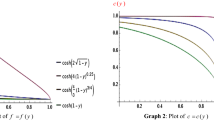Abstract
Horizontal distribution of the copepodNeocalanus cristatus was shown to be fractal on the scale between tens of meters and over 100 km. The fractal dimensions ranged between 1.68–1.89, significantly higher than those of oceanic turbulence and phytoplankton distribution.
Similar content being viewed by others
References
Berry, M. V. and Z. V. Lewis (1980): On the Welerstrass-Mandelbrot function.Proc. Royal Soc. Lond.,A370, 459–484.
Caddy, J. F. and C. Stamatopoulos (1990): Mapping growth and mortality rates of crevice-dwelling organisms onto a perforated surface: The relevance of “cover” to the carrying capacity of natural and artificial habitats.Est. Coast. Shelf Sci.,31, 87–106.
Denman, K. L. and T. Platt (1976): The variance spectrum of phytoplankton in a turbulent ocean.J. Mar. Res.,34, 593–601.
Dicke, M. and P. A. Burrough (1988): Using fractal dimensions for characterizing tortuosity of animal trails.Physiol. Entomol.,13, 393–398.
Fasham, J. J. R., M. V. Angel and H. S. J. Roe (1974): An investigation of the spatial pattern of zooplankton using the Longhurst-Hardy plankton recorder.J. Exp. Mar. Biol. Ecol.,16, 93–112.
Fox, C. G. (1989): Empirically derived relationships between fractal dimension and power law form frequency spectra.Pageoph.,131, 211–239.
Hardy, A. C. (1936): Observation on the uneven distribution of oceanic plankton.Discovery Rep.,11, 511–538.
Higuchi, T. (1990): Relationship between the fractal dimension and the power law index for a time series: A numerical investigation.Physica D,46, 254–264.
Mackas, D. L. and C. M. Boyd (1979): Spectral analysis of zooplankton spatial heterogeneity.Science,204, 62–64.
Mandelbrot, B. B. (1967): How long is the coast of Britain? Statistical self-similarity and fractional dimension.Science,156, 636–638.
Mandelbrot, B. B. (1982):The Fractal Geometry of Nature. W. F. Freeman and Company, New York.
McKinney, M. L. and D. Frederick (1992): Extinction and population dynamics: New methods and evidence from paleogene foraminifera.Geology,20, 343–346.
Miller, C. B., B. W. Frost, H. P. Batchelder, M. J. Clemons and R. E. Conway (1984): Life histories of large, grazing copepods in a subarctic ocean gyre:Neocalanus plumchrus, Neocalanus cristatus, andEucalanus bungii in the northeast Pacific.Prog. Oceanog.,13, 201–243.
Morse, D. R., J. H. Lawton, M. M. Dodson and M. H. Williamson (1985): Fractal dimension of vegetation and the distribution of arthropod body lengths.Nature,314, 731–733.
Osborne, A. R. and R. Caponio (1990): Fractal trajectories and anomalous diffusion for chaotic pattern motions in 2D turbulence.Phys. Rev. Lett.,64, 1733–1736.
Osborne, A. R., A. D. Kirwan, Jr., A. Provenzale and L. Bergamasco (1989): Fractal drifter trajectories in the Kuroshio extension.Tellus,41A, 416–435.
Pennycuick, C. J. and N. C. Kline (1986): Units of measurement for fractal extent, applied to the coastal distribution of bald eagle nests in the Aleutian Islands, Alaska,Oecologia,68, 254–258.
Richardson, L. F. (1922):Weather Prediction by Numerical Process. Cambridge Univ. Press, London.
Sanderson, B. G. and D. A. Booth (1991): The fractal dimension of drifter trajectories and estimates of horizontal eddy-diffusivity.Tellus,43A, 334–349.
Sreenivasan, K. R. and C. Meneveau (1986): The fractal facets of turbulence.J. Fluid Mech.,173, 357–386.
Steele, J. H. (1989): The ocean “landscape”.Landscape Ecol.,3, 185–192.
Steele, J. H. and E. W. Henderson (1992): A simple model for plankton patchiness.J. Plankton Res.,14, 1397–1403.
Sugihara, G. and R. M. May (1990): Applications of fractals in ecology.TREE,5, 79–86.
Tsuda, A. and H. Sugisaki (1994):In situ grazing rate of the copepod population in the western subarctic North Pacific during spring.Mar. Biol.,120, 203–210.
Tsuda, A., H. Sugisaki, T. Ishimaru, T. Saino and T. Sato (1993): White-noise-like distribution of the oceanic copepodNeocalanus cristatus in the subarctic North Pacific.Mar. Ecol. Prog. Ser.,97, 39–46.
Author information
Authors and Affiliations
Rights and permissions
About this article
Cite this article
Tsuda, A. Fractal distribution of an oceanic copepodNeocalanus cristatus in the subarctic pacific. J Oceanogr 51, 261–266 (1995). https://doi.org/10.1007/BF02285164
Received:
Revised:
Accepted:
Issue Date:
DOI: https://doi.org/10.1007/BF02285164



